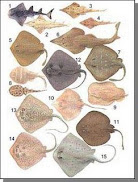
Fly fishing is a distinct and ancient angling method, most renowned as a method for catching trout and salmon, but employed today for a wide variety of species including pike, bass, panfish, and carp, as well as marine species, such as redfish, snook, tarpon, bonefish and striped bass. There are many reports of fly fisherman taking quite unintended species such as chub, bream and rudd while fishing for ‘main target’ species such as trout. There is a growing population of anglers whose aim is to catch as many different species as possible with the fly.
In fly fishing, fish are caught by using artificial flies that are cast with a fly rod and a fly line. The fly line (today, almost always coated with plastic) is heavy enough cast in order to send the fly to the target. Artificial flies can vary dramatically in all morphological characteristics (size, weight, colour, etc.).

Artificial flies are created by tying hair, fur, feathers, or other materials, both natural and synthetic, onto a hook with thread. The first flies were tied with natural materials, but synthetic materials are now extremely popular and prevalent. The flies are tied in sizes, colours and patterns to match local terrestrial and aquatic insects, baitfish, or other prey attractive to the target fish species.

Unlike other casting methods, fly fishing can be thought of as a method of casting line rather than lure. Non-flyfishing methods rely on a lure’s weight to pull line from the reel during the forward motion of a cast. By design, a fly is too light to be cast, and thus simply follows the unfurling of a properly casted fly line, which is heavier and more castable than lines used in other types of fishing. The angler normally holds the flyrod in the dominant hand and manipulates the line with the other close to the reel, pulling line out in small increments as the energy in the line, generated from backward and forward motions, increases. The mechanics of proper rod movement are commonly described as “10 to 2″, meaning that the rod’s movement on the forward cast is arrested at the 10 o’clock position (12 o’clock is rod straight up, 9 o’clock flat forward, 3 o’clock flat backwards) and the backcast at 2 o’clock. In proper casting, loops of line unfurl completely before the angler throws his rod in opposite direction. The effect resembles sending a wave along a garden hose to remove a kink. Newer casting techniques promote minimal wrist movement, a very open stance and movement of the arm parallel to the ground, discouraging the rigid boundaries of the 10 to 2 technique. Proper casting, regardless of technique, requires pauses in both directions (forward and backward) to allow the entirety of the line to unfurl parallel to the water’s surface. As additional line length is desired for farther casts, the angler allows momentum generated by the forward and backcasting to carry slack line previously pulled free from the reel to glide forward through the non-dominant hand. Flyline speed and orientation in three-dimensional space, in both the forward and back cast, yield a tighter or looser unfurling of the “loop” of line. As rhythm and line control improve, longer and more accurate casts can be achieved. Poor casts typically lead to tangled lines that pile up on the water’s surface in front of the angler as he attempts to allow the fly come to rest.
In broadest terms, flies are categorized as either imitative or attractive. Imitative flies resemble a natural food items. Attractive flies trigger instinctive strikes by employing a range of characteristics that do not necessarily mimic prey items. Flies can be fished floating on the surface (dry flies), partially submerged (emergers), or below the surface (nymphs, streamers, and wet flies.) A dry fly is typically thought to represent an insect landing on, or emerging from, the water’s surface as might a grasshopper, dragonfly, mayfly, stonefly or caddisfly. Other surface flies include poppers and hair bugs that might resemble mice, frogs, etc. Sub-surface flies are designed to resemble a wide variety of prey including aquatic insect larvae, nymphs and pupae, baitfish, crayfish, leeches, worms, etc. Wet flies, known as streamers, are generally thought to imitate minnows or leeches.




















